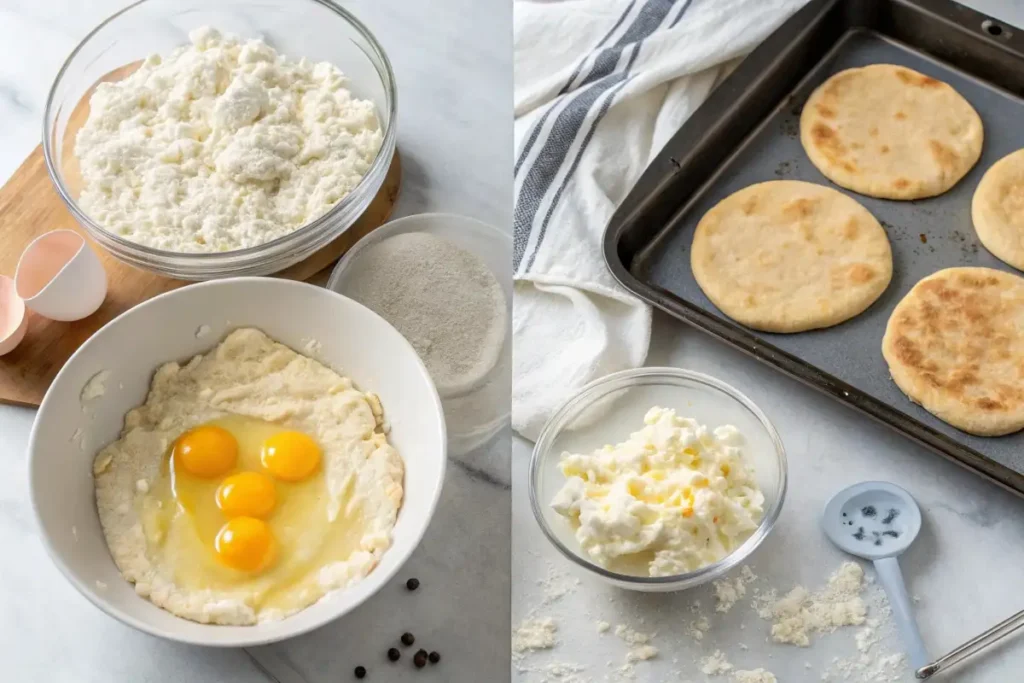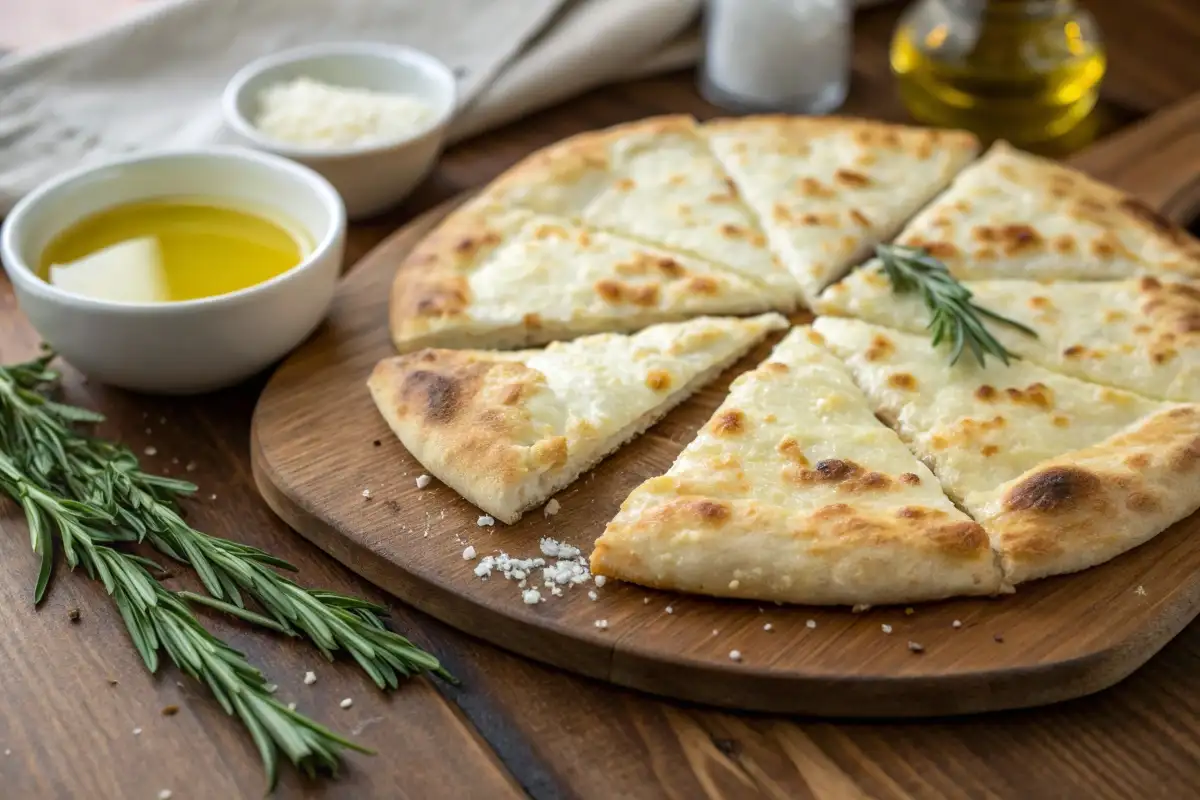If you’re looking for a high-protein, low-carb alternative to traditional bread, then cottage cheese flatbread is the perfect choice. This delicious, nutrient-rich flatbread is easy to make, incredibly versatile, and works with both sweet and savory toppings. Whether you’re into healthy baking or just love experimenting with new flatbread recipes, this article has you covered.
We’ll start with a brief introduction to cottage cheese flatbread, exploring its origins and how it stands out from other breads. Then, we’ll dive into its health benefits, followed by a step-by-step guide to making it at home. We’ll also explore some creative variations and serving ideas to inspire you. Finally, we’ll answer some common FAQs to ensure you get the best results every time. Let’s get started!
Introduction to Cottage Cheese Flatbread
What is Cottage Cheese Flatbread?
Cottage cheese flatbread is a protein-packed, low-carb alternative to traditional bread, made primarily from cottage cheese, eggs, and a binding agent like flour or psyllium husk. Unlike store-bought breads loaded with preservatives, this homemade flatbread is wholesome, fresh, and incredibly nutritious.
With a soft yet slightly crispy texture, this healthy bread substitute is ideal for wraps, sandwiches, or as a pizza base. You can make it gluten-free or add herbs and spices to enhance the flavor. Plus, it’s an excellent option for those following keto, high-protein, or low-carb diets.
Historical Background and Origins
Flatbreads have been around for centuries, with origins dating back to ancient civilizations like Mesopotamia and Egypt. Traditional flatbreads, such as naan and pita, rely on wheat-based flours, but modern dietary trends have led to low-carb alternatives—enter cottage cheese flatbread.
While this specific recipe doesn’t have a long historical record, its concept is a modern twist on traditional protein-rich breads. Cottage cheese itself has been a staple dairy product for centuries, praised for its high protein content and creamy texture. By incorporating it into flatbread recipes, home cooks and health enthusiasts have discovered an easy, nutritious way to enjoy bread without guilt.
Health Benefits of Cottage Cheese Flatbread
When it comes to healthy bread substitutes, few options compare to cottage cheese flatbread. Not only is it delicious and versatile, but it also offers a range of health benefits that make it a great addition to any diet.
High Protein Content and Muscle Building
One of the biggest advantages of cottage cheese flatbread is its high protein content. Since it’s made with cottage cheese and eggs, it delivers a rich source of protein, which helps with muscle growth and repair. If you work out regularly or follow a high-protein diet, this flatbread can help you stay full longer and support your fitness goals.
Protein is also crucial for metabolism, as it takes more energy to digest compared to carbs and fats. This means that eating protein-rich foods like cottage cheese flatbread can help burn more calories throughout the day.
Low-Carbohydrate Option for Weight Management
If you’re watching your carbs, this low-carb bread alternative is an excellent choice. Unlike traditional flatbreads, which are made from refined flour, cottage cheese flatbread contains fewer carbs, making it perfect for keto and low-carb diets.
By replacing regular bread with this nutritious alternative, you can reduce carb intake without giving up the joy of eating homemade flatbread. Plus, lower-carb diets have been linked to better blood sugar control, making this a smart choice for those managing diabetes or insulin resistance.
Rich in Essential Nutrients
Beyond protein, cottage cheese flatbread is packed with important vitamins and minerals. Cottage cheese is a great source of calcium, which is essential for strong bones and teeth. It also contains B vitamins, which help with energy production and brain function.
Unlike processed store-bought bread, this homemade flatbread keeps all the natural nutrients intact. By making it yourself, you can enjoy clean, nutrient-rich food without unhealthy additives.
How to Make Cottage Cheese Flatbread at Home
Making cottage cheese flatbread at home is easier than you think. With just a few simple ingredients and a little time, you can bake a soft, flavorful flatbread that pairs well with savory or sweet toppings.

Ingredients Needed
To make a basic cottage cheese flatbread, you’ll need:
- 1 cup cottage cheese (full-fat or low-fat)
- 2 large eggs
- ½ cup almond flour (or any flour of choice)
- ½ teaspoon baking powder
- ½ teaspoon salt
- ¼ teaspoon garlic powder (optional for extra flavor)
- 1 tablespoon olive oil (for a softer texture)
This recipe is flexible, so you can easily adjust it based on your dietary needs. For a gluten-free version, stick to almond or coconut flour. If you want a crispier texture, try adding a bit of psyllium husk or flaxseed meal.
Step-by-Step Preparation Guide
- Preheat the Oven – Set your oven to 375°F (190°C) and line a baking sheet with parchment paper.
- Blend the Ingredients – In a food processor or blender, mix the cottage cheese, eggs, and olive oil until smooth.
- Add Dry Ingredients – In a separate bowl, whisk together flour, baking powder, salt, and garlic powder. Then, gradually mix it into the wet ingredients.
- Form the Dough – The dough will be slightly sticky. Let it sit for 5 minutes to thicken before handling.
- Shape the Flatbread – Spread the dough on the lined baking sheet, shaping it into a thin oval or rectangle. You can also divide it into smaller pieces for individual portions.
- Bake to Perfection – Place in the oven and bake for 15-18 minutes until golden brown. Let it cool slightly before slicing.
Tips for Achieving the Perfect Texture
- For a softer flatbread, use a bit more olive oil or cottage cheese.
- If you prefer it crispy, bake it a few minutes longer or cook it on a hot skillet after baking.
- Experiment with herbs and spices like oregano, basil, or chili flakes for extra flavor.
- Let the flatbread cool completely before storing to prevent sogginess.
Now that you know how to make cottage cheese flatbread, you can customize it with your favorite flavors and enjoy a healthy, homemade alternative to regular bread.
Popular Variations of Cottage Cheese Flatbread
Cottage cheese flatbread is not only nutritious but also incredibly versatile, allowing for numerous variations to suit different tastes and dietary needs.

Incorporating Herbs and Spices
Enhance the flavor of your flatbread by adding herbs and spices directly into the batter. Mix in oregano, garlic powder, or Italian seasoning to infuse the bread with aromatic notes. For a spicy kick, consider adding chili flakes or paprika. These additions not only boost taste but also complement various toppings and fillings. citeturn0search4
Sweet vs. Savory Versions
While traditional flatbreads are savory, cottage cheese flatbread can easily be adapted for sweet applications. For a sweet twist, omit savory spices and incorporate a touch of honey or cinnamon into the batter. Once baked, top with fresh fruits like strawberries and a drizzle of Nutella, or spread with peanut butter and banana slices for a delightful breakfast or dessert option. citeturn0search10
Regional Twists and Recipes
Different cultures have their own versions of cheese-filled flatbreads. For instance, the Circassian haliva is a fried turnover filled with cottage cheese and herbs, offering a crispy alternative to the baked version. Similarly, the Sicilian scaccia features layers of dough stuffed with cheese and vegetables, providing a hearty meal option. Experimenting with these regional inspirations can add exciting new flavors to your cottage cheese flatbread repertoire. citeturn0search28turn0search32
For more delicious recipes, check out our recipe collection.
Culinary Uses and Serving Suggestions
The adaptability of cottage cheese flatbread makes it a fantastic addition to various meals. Here are some serving ideas to inspire your next culinary creation:

As a Base for Pizzas
Transform your flatbread into a personalized pizza by adding your favorite toppings. Spread a layer of tomato sauce or pesto, sprinkle with mozzarella cheese, and add vegetables, meats, or herbs of your choice. Bake until the cheese melts and bubbles for a quick and healthy pizza night. citeturn0search9
Using as a Wrap or Sandwich Bread
Thanks to its pliable nature, cottage cheese flatbread serves as an excellent wrap or sandwich base. Fill it with grilled chicken, fresh vegetables, and a smear of hummus for a protein-packed lunch. Alternatively, create a breakfast wrap with scrambled eggs, avocado, and turkey bacon. The possibilities are endless, and the flatbread’s neutral flavor complements a wide range of fillings. citeturn0search12
Pairing with Dips and Spreads
Cut the flatbread into smaller pieces and serve it alongside your favorite dips and spreads. It pairs well with tzatziki, spinach artichoke dip, or a simple olive oil and balsamic vinegar mix. This makes for an appealing appetizer or snack during gatherings. citeturn0search10
For more delicious recipes, check out our recipe collection.
These variations and serving suggestions highlight the versatility of cottage cheese flatbread, making it a delightful addition to any meal.
Frequently Asked Questions
When trying a new recipe like cottage cheese flatbread, you may have some questions about ingredients, storage, and substitutions. Below are answers to some of the most common inquiries.
Is Cottage Cheese Flatbread Suitable for Gluten-Free Diets?
Yes! If you use almond flour, coconut flour, or another gluten-free alternative, this flatbread is completely gluten-free. Since cottage cheese flatbread doesn’t rely on traditional wheat flour, it’s a great option for those avoiding gluten. Just be sure to check that all your ingredients are labeled gluten-free.
Can I Store and Reheat Cottage Cheese Flatbread?
Absolutely! Cottage cheese flatbread can be stored in an airtight container in the fridge for up to 3-4 days. To reheat, simply warm it in a skillet, oven, or toaster oven for a few minutes until it becomes soft and slightly crispy again. Avoid using the microwave, as it can make the flatbread too soft and chewy.
If you want to keep it longer, freeze individual portions by placing parchment paper between each piece and storing them in a freezer-safe bag. To reheat, thaw overnight in the fridge and warm it in the oven.
What Are Some Vegan Alternatives to Cottage Cheese in Flatbread Recipes?
For a dairy-free or vegan version, you can replace cottage cheese with blended tofu, cashew cheese, or a plant-based yogurt alternative. While the texture may be slightly different, these options still provide a creamy and protein-rich base. You’ll also need to substitute the eggs with a flaxseed or chia seed egg replacement to bind the ingredients together.
Conclusion
Homemade cottage cheese flatbread is a fantastic, nutritious alternative to traditional bread. Not only is it high in protein and low in carbs, but it’s also easy to make and highly versatile. Whether you enjoy it as a pizza base, sandwich wrap, or paired with dips, there are endless ways to customize it to your taste.
Now that you have the step-by-step guide and expert tips, it’s time to start baking! Experiment with different flavors and share your favorite combinations. For more healthy and delicious recipes, be sure to check out our recipe collection!

